Elegoo Saturn
Two-minute review
The Elegoo Saturn is a mid-sized MSLA printer that closely resembles a scaled-up version of one of the Elegoo Mars series of printers from the same company. If you've even slightly dipped your toes into the world of 3D printing, chances are you'll have heard about Elegoo from numerous YouTube reviews and online resin printing tutorials, with the Elegoo Mars making a frequent appearance thanks to its affordability and reputation for reliable, high-quality prints.
This obviously means that the fresh-faced Elegoo Saturn has some pretty big shoes to fill. Thankfully, it can print some big shoes of its own. Its larger size stands out as a benefit to consumers looking for something with a larger-sized print bed to accommodate bigger prints, reducing printing time for models that would have previously needed to be cut into sections using software and then printed in batches for later reassembly.
A quick explanation for anyone who isn't familiar with 3D printers, consumer models generally fall into just two categories: stereolithographic (SLA) and fused deposition modeling (FDM).
FDM-type printers use a melted filament to build up a model layer by layer onto a heated bed, with a motor-controlled nozzle moving around to create your design. SLA printers use a print bed submerged into a vat of UV reactive resin, and then a LED light system will flash, curing each layer within the tank. The Elegoo Saturn falls into the latter category, which means there are a vast array of pros and cons when stacked up against FDM printers like the Anycubic Vyper.
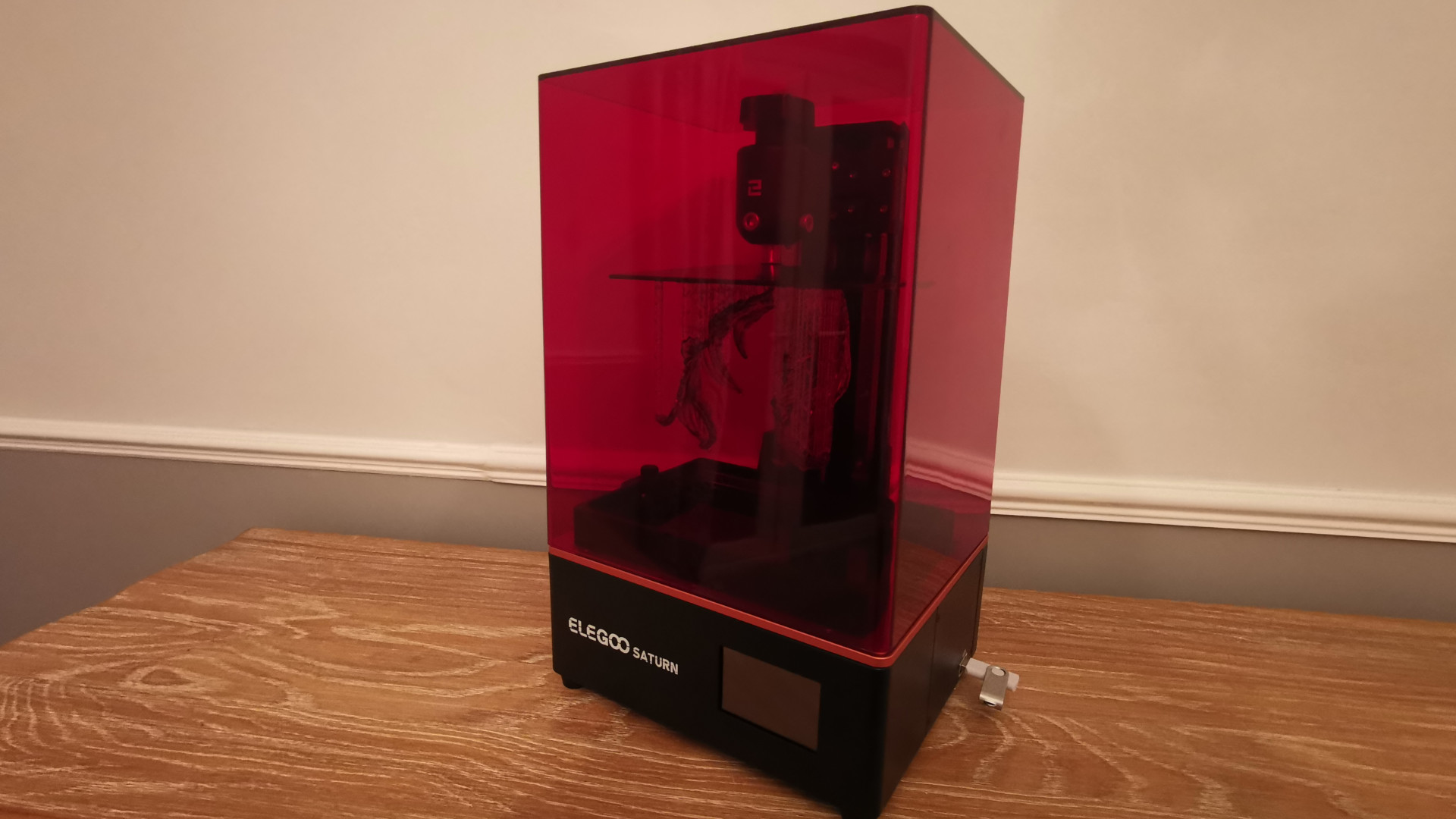
While FDM printers can typically print at much larger sizes owing to their available print bed volume, they struggle to pick up fine details and many prints, even the well-optimized ones, will have lines running throughout where the layers were built up. Resin-based printers on the other hand succeed in delivering great detail in their prints, but the size is typically much more constricted.
This is where Printers like the Elegoo Saturn will win some favors from consumers looking to print bigger models, with higher detail than what's achievable using FDM printers, and thankfully, it delivers on that beautifully.
The Saturn printed reliably and at a much faster speed than an FDM printer too, and the only major gripes we found were those typical of all resin-based printers, and therefore not restricted to this particular product itself. It does exactly what it sets out to do with minimal fuss, equipping you with the means to bring your ideas into a resin-submerged reality.
The Elegoo Saturn MSLA printer is available through the Elegoo website or third-party retailers like Amazon, with many region-specific links listed directly on the Saturn product page.
You can expect to pay $500 / £440 / AU$700, though we note that stock availability can vary depending on your location, with many of the Australian sites listing the Elegoo Saturn as 'out of stock'.
Design
These are the specifications for the Elegoo Saturn:
Operation: 3.5 inch Touch Screen
Software: Chitu Box
Connectivity: USB
Technology: LCD-based SLA UV Photocuring
Light-source: high-quality filament (wavelength 405nm)
XY Res.: 0.050mm 3840*2400(4K)
Z Axis Res.: 0.00125mm
Layer Res.: 0.01-0.15mm
Printing Speed: 30mm/h
Printer Size: 280mm(L) *240mm(W) *450mm(H)
Build Volume: 192mm(L) *120mm(W) *200mm (H)
Material: UV Resin
Net Weight: 13.5kg
There's minimal assemble required for the Elegoo Saturn, and the packaging is protected with plenty of foam and plastic sheeting to prevent any dents or scratches during shipping.
You'll also get a kit with some accessories to help both assembly and the printing process itself, with latex gloves and paper filters for cleaning resin after use, spare bolts, some paper facemasks to protect you from resin fumes, and a USB drive that you'll use to load STL files into the printer.
You also get a few tools in the kit, such as some wire cutters for removing supports, a plastic scraper for delicately removing any failed prints from the FEP sheet and a metal scraper for removing prints from the build plate. These are sufficient but you'd fare better buying some professional quality tools if you're planning to print frequently.
As mentioned, the overall design of the Elegoo Saturn is similar to its existing Elegoo Mars line of resin printers, though noticeably bigger if you compare the two side-by-side. As with many SLA and MSLA printers, the Saturn has a submergible build plate and a vat for resin. You get a semi-transparent red hood to keep out UV and other debris from falling into the resin, with a touch-reactive 3.5-inch screen located on the front of the printer to operate it.
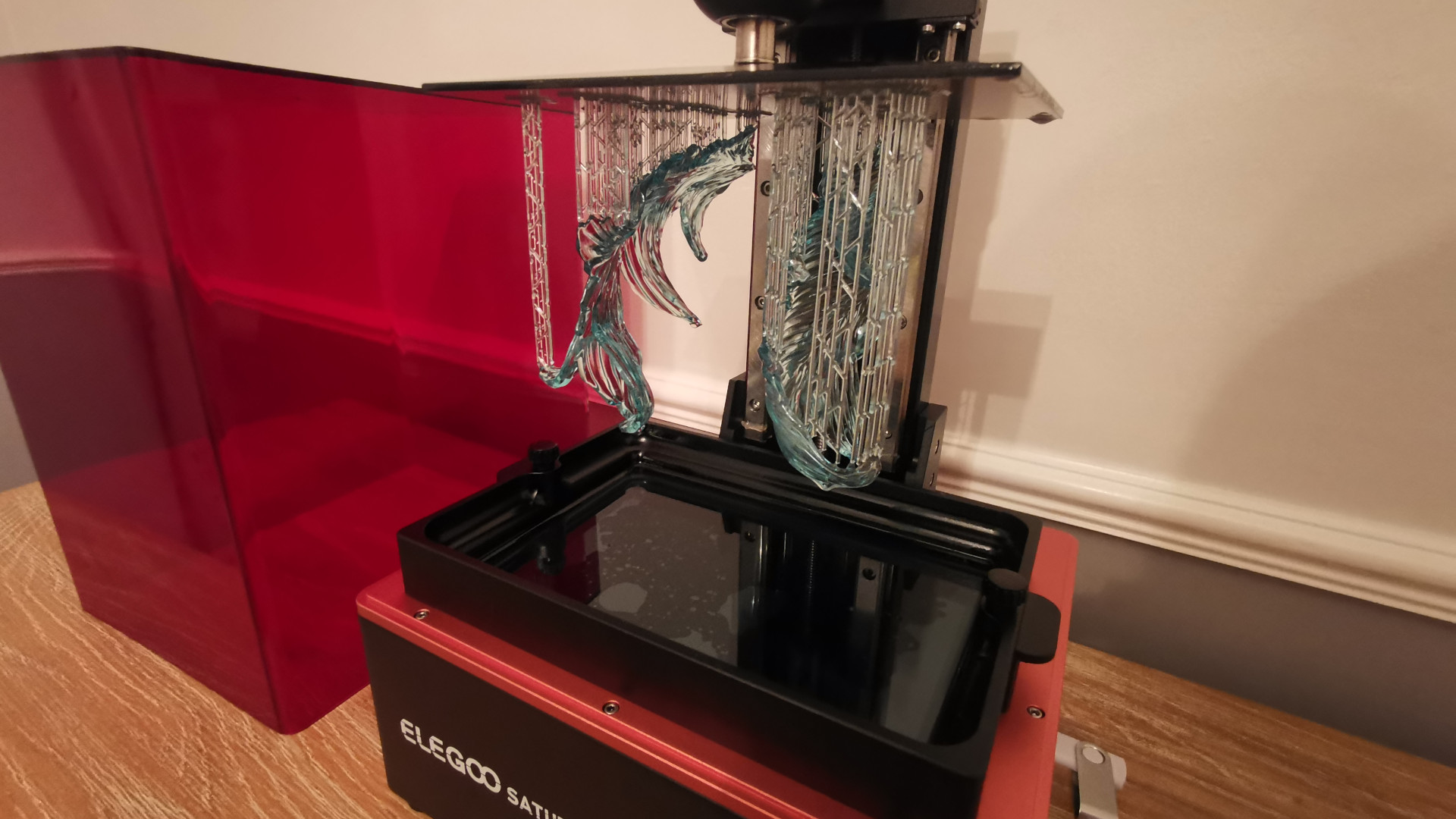
The chassis that contains all the important mechanisms is metal, so the printer is fairly heavy (weighing in at 13.5kg), though an adult will have little issues moving it around. You might want to supervise any children around it though, not just due to its heft, but also because working with resin requires you to pay close attention to health and safety. Always make sure you're wearing gloves and either a disposable face mask or a professional respirator that's rated for fumes.
Elegoo likes to mix up the location of the USB port on its machines, but while models like the Mars 2 pro have it located on the back of the printer (requiring you to move the printer or leave access to the rear, which isn't ideal), the Saturn, thankfully, has it on the right-hand side.
Having it on the front would have made more sense to us to allow easier access and reduce the need to move the printer around (and recalibrate it as a result), but it's certainly preferable to having it on the rear. Still, the power switch for the printer is still located on the back, so take care when trying to switch the device on or off.
You can also plug the Saturn into a network connection via an available port on the rear, which is ideal for people looking to add a larger printer to a high-volume printing setting or farm. Using an ethernet, you can control the Elegoo Saturn remotely from a laptop or PC.
The aforementioned resin tank is a blessing compared to some other models on the market that use a side-mounting system. Instead, the Saturn is top-mounted, which makes the process of removing it much easier and less prone to spillage. You also get a handy 'spout' on one side to help you decant out resin back into the bottles, so Elegoo is clearly taking steps to keep users clean of unnecessary resin-related mess.
Features
The Saturn has an 8.9-inch masking LCD with a 4K resolution of 3840 x 2400, so you're getting an XY resolution of .05mm, or 50 microns, compared to the ever so slightly more detailed 0.047 mm (47 microns) found on the Mars and Mars Pro. Smaller is better regarding microns for resin printers as it allows for finer detail, but a difference of 3 microns is going to be indistinguishable to the eye. If you've used the Mars or Mars Pro printer and were happy with your print results, chances are you'll love the Saturn's quality too.
Take note that the LCD will have a protective film on it to protect it during shipping, and this will need to be removed prior to use, but take care to not remove the black tape that surrounds the screen itself.
The Saturn lacks an air filter and a rubber seal like those seen in the Elegoo Mars 2 Pro, so make sure you're setting it up in a well-ventilated area. Even without the air filter, the cooling fans can be a little loud, but providing you're not trying to sell in the same room while it's operating (which we would advise against), you won't hear it behind a closed door.
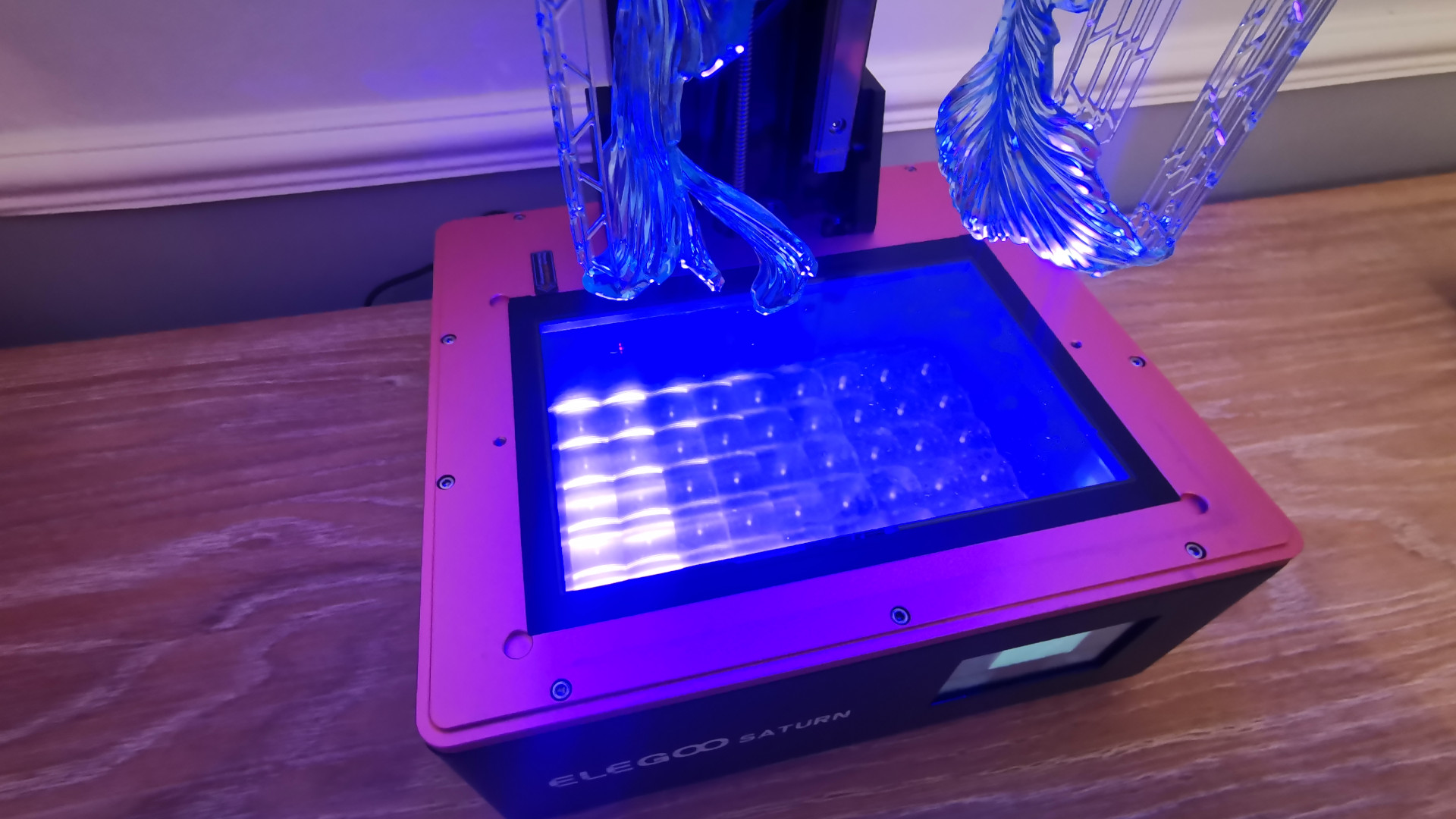
The build plate for the Saturn will need leveling before you start pouring resin into the vat, but the process to do this is very straightforward, more so than many other popular printers on the market. All you need is a piece of paper, something that's supplied in the box, but a standard piece of printing paper will work just as well.
Simply loosen the two bolts on the build platform using the allen key supplied and place a sheet of paper over the LCD display. The Elegoo Saturn can then be set to self-level, after which you just need to re-tighten the bolts and you're ready to start printing.
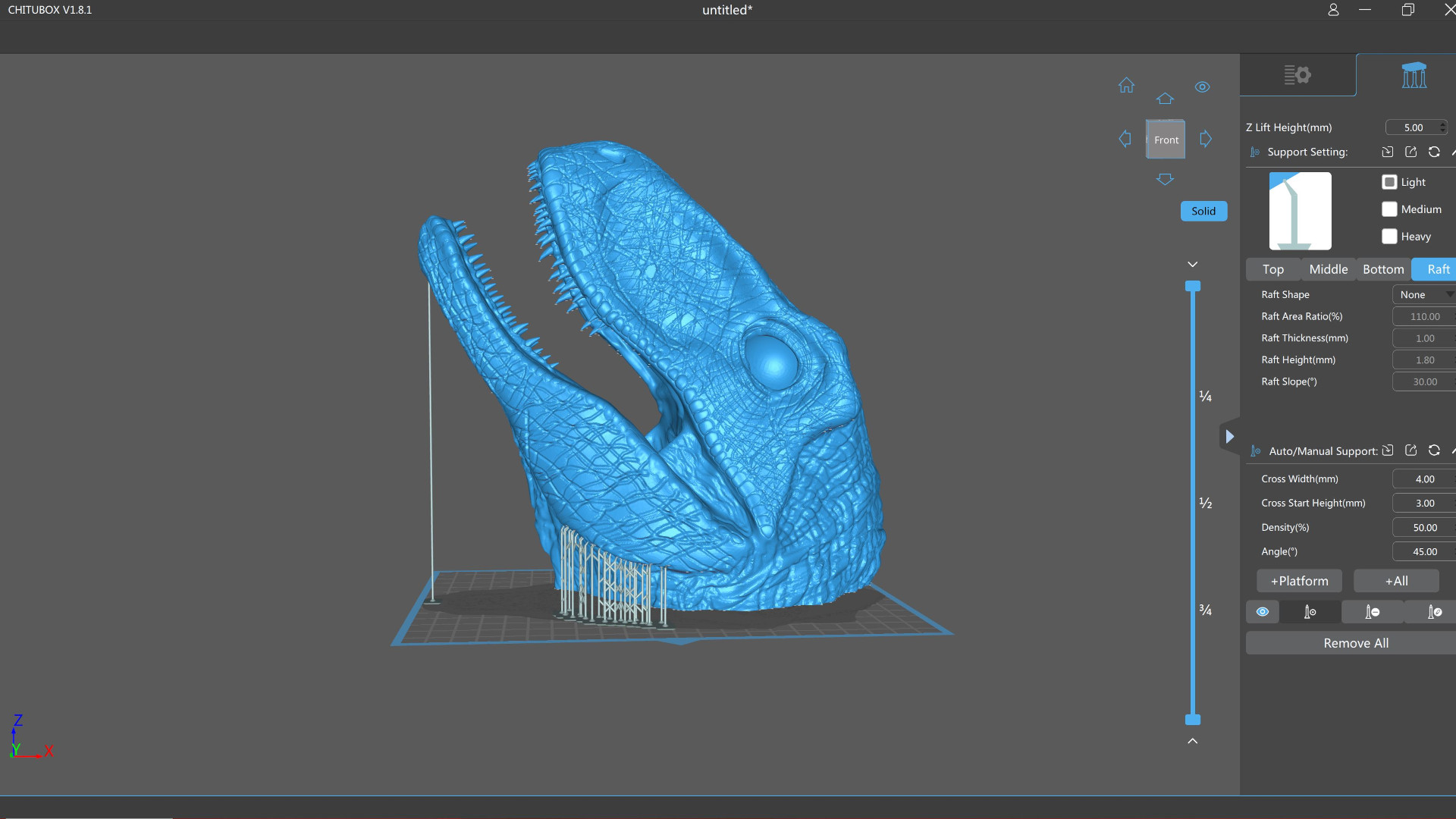
The Elegoo Saturn has a few files included on the USB drive that it ships with, including a download for the ChituBox slicing software. We found that the printer profiles were already available so you shouldn't need to manually upload them yourself, and the software allows you to make the usual adjustments to optimize your prints.
The application itself is very user friendly while also being feature-packed, eliminating the need for secondary programs. ChituBox can generate supports for files and estimate how much resin you'll need to complete a print, as well as estimated costs. There are other applications that you can use with Elegoo printers, but we certainly don't have any complaints about this software.
Performance
There are a few different resin types offered by Elegoo such as 'Eco' and 'Water Washable', but we opted for the standard in opaque black. The supplied test files that come pre-loaded onto the USB drive are something we call a 'torture test' or bench, a model designed to put a printer through its paces with a complicated design.
Right off the bat, there's a glaring issue with these files that reflects poorly on the printer if you've never tried 3D printing before. As they're unsupported and built directly onto the build plate, it's almost impossible to remove them without damaging the model as they adhere very strongly. The metal scraper supplied in the Elegoo Saturn kit is too thick to slide underneath the model so you're just going to cause damage trying to dislodge them.
If you find yourself in the same predicament there are a few things you can do. One would be to load the file into ChituBox and manually add your own supports to elevate it from the build plate. Another is to buy a razor window scraper that can wriggle under the build, or pour boiling hot water over where the print is stuck to gently expand the plastic and help it dislodge more easily.
Something we would have loved to see is a FlexPlate system, a slim magnetic cover for the build plate that allows easy removal of stuck prints due to its flexibility. You can buy these from a range of different 3D printing websites, but it would have been a great idea for Elegoo to implement something similar into the Saturn design.
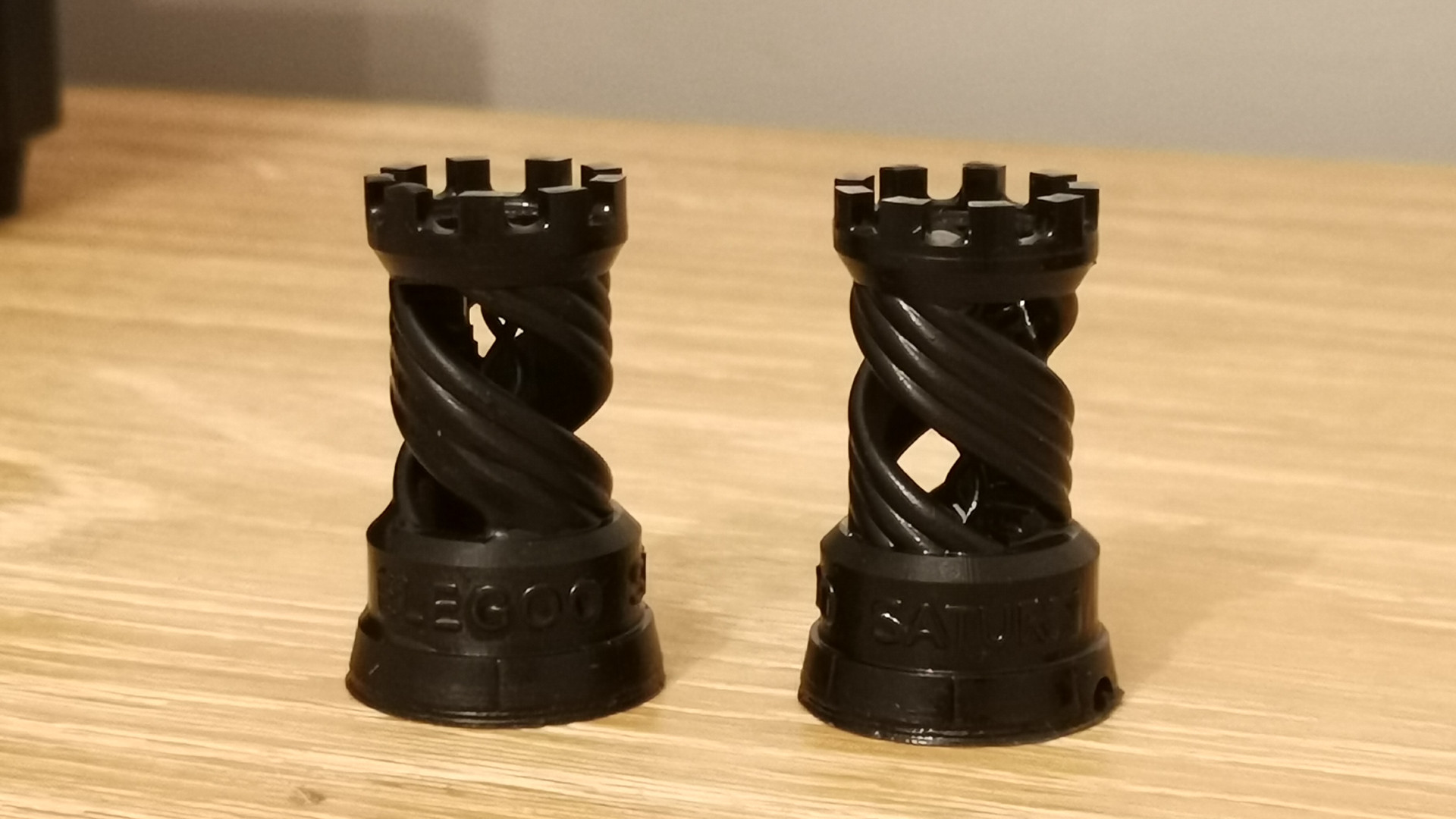
Removal difficulty aside, the benchmark prints were a success, with all areas of the models printing with no detectable issues. Alongside other benchmarks, we ran a test print of a minuscule goblin figurine to see how much detail the Saturn could pick up on a smaller scale and we were pleasantly surprised by how small you can go. The loincloth is so thin that you can see light shining through, but all of the detail has been picked up and despite its sheerness, it printed without snapping.
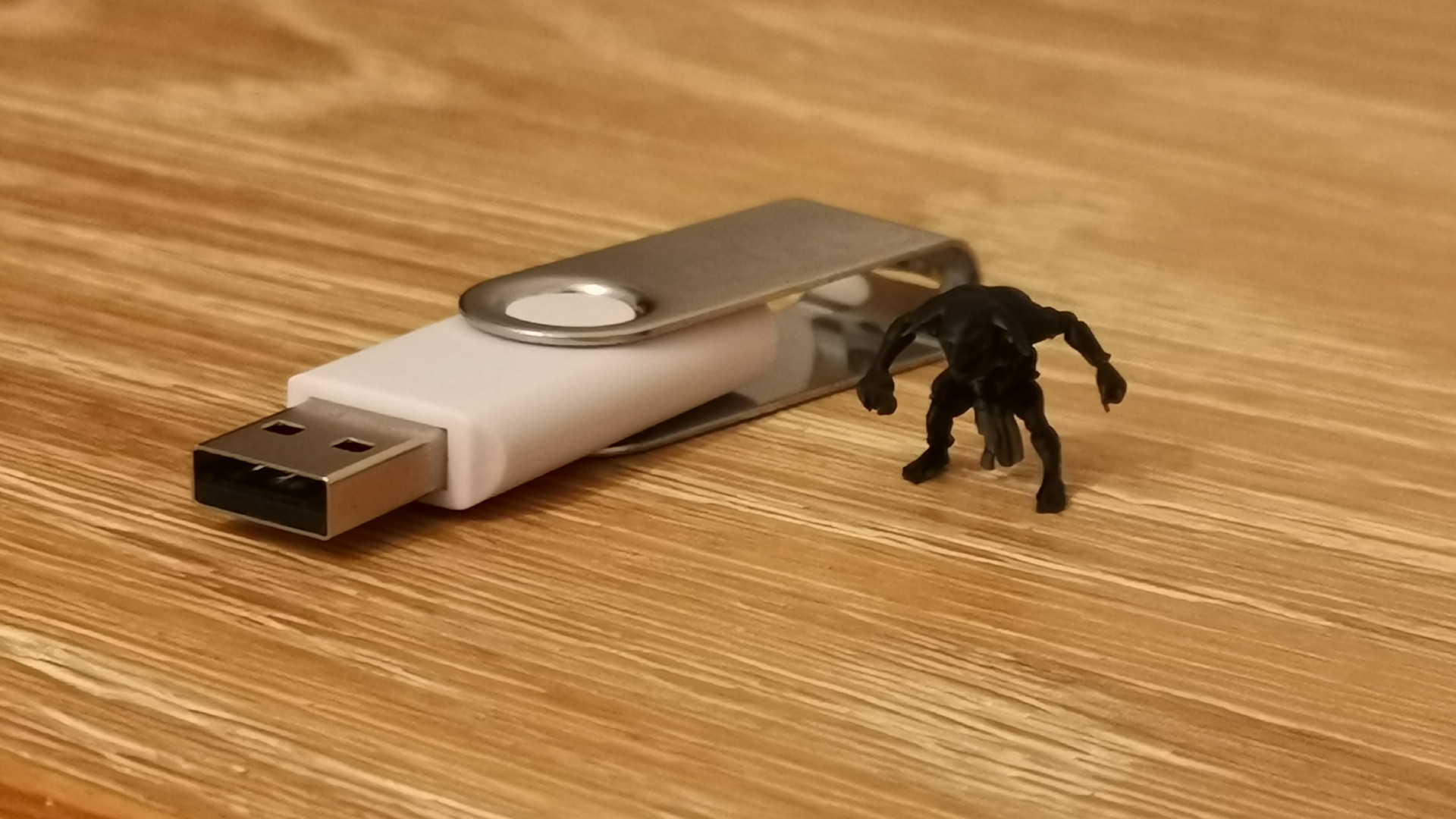
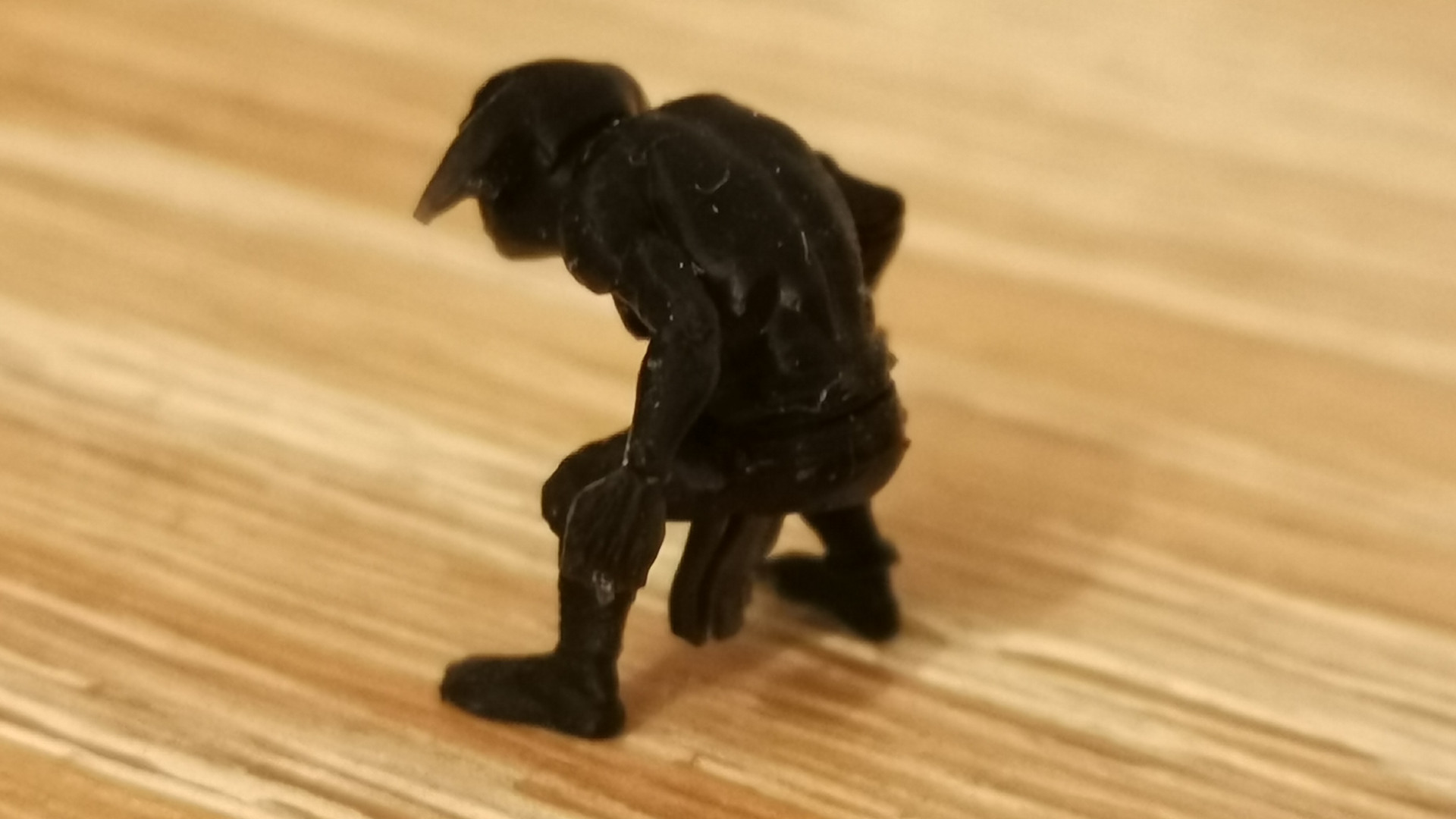
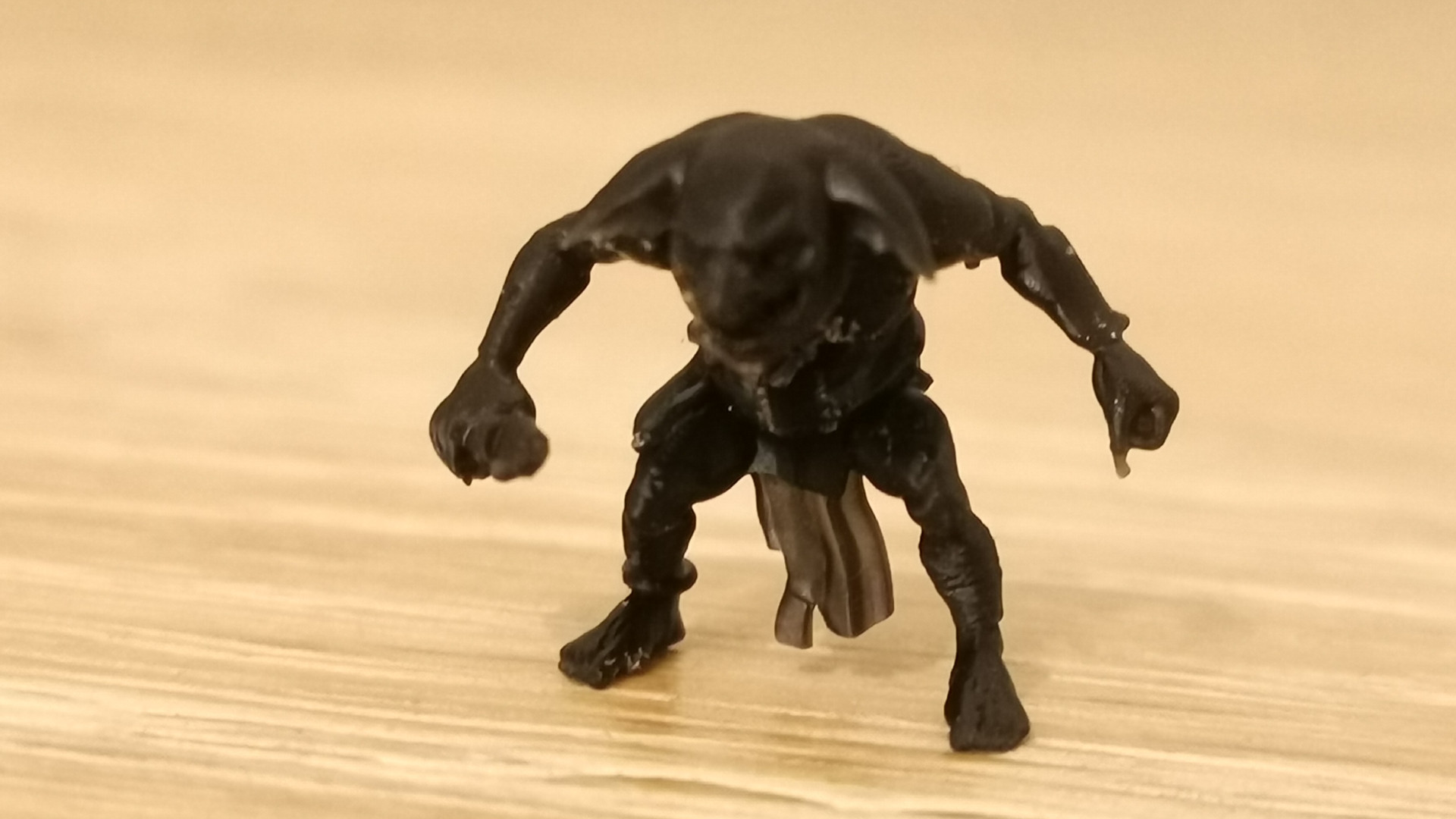
In fact, every model we printed on the Elegoo Saturn was crisp and clean. You have to be careful with the delicate PEF film at the bottom of the resin tray (the thin, clear plastic film that contains resin while allowing curing UV light to pass through) as it can easily be pierced if you're trying to clean any resin that's started to cure on the surface, and Elegoo doesn't provide any replacement sheets in the box. Thankfully, you can buy these easily online, typically on the same website you used to purchase the printer so we would advise grabbing a pack of replacements for when an accident occurs.
In all, this is a great MSLA printer and it's no wonder that stock issues have reared their head. With its larger size, printing enthusiasts don't have to compromise quality to upscale the size of their models so the high demand is to be expected. If you find one in stock, the Elegoo Saturn is a fantastic buy for both newcomers to 3D printing and seasoned veterans looking for a mid-sized printer.
Buy it if...
You want to print bigger figurines
With a build volume of 192mm(L) x 120mm(W) x 200mm (H), you won't need to separate your models into small pieces within slicing software. Not only that, but you have more space available to print smaller models in greater quantities.
You need fine details on your prints
Compared to FDM printers and some other SLA printers on the market, the Elegoo Saturn makes light work of complex models that have a lot of small details on them.
You don't want to complicate things
From unboxing to printing our test benchmark, the entire setup was quick and very straightforward and only took around 20 minutes. In fact, there's very little about the Saturn that's complex.
Don't buy it if...
Time is of the essence
Depending on your location, you might find the Elegoo Saturn is harder to find than gold dust due to high demand, though things do seem to be improving in certain regions.
You don't have a lot of space
It's far from the biggest 3D printer on the market, but if you need something small and lightweight to fit into a cramped shelf, the Saturn might be a little too large for some desktops.
- We've also highlighted the best 3D printers
0 comments:
Post a Comment